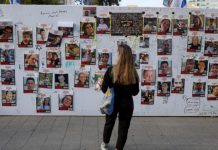On Wednesday, the fifth day of protests, thousands of demonstrators marched through Iran amid unrest over the death of Mahsa Amini.
The 22-year-old woman died in police custody after she was arrested for allegedly wearing a headscarf in an „improper” way under the Islamic Republic’s strict dress code for women.
Amjad Amini said doctors had refused to let him see his daughter after her death. When he viewed his daughter’s body leading up to her funeral it was entirely wrapped except for her feet and face – though he noticed bruising on her feet. „I have no idea what they did to her”, he said.
Officials said on Wednesday that two people, including a police officer and a teenager, died overnight as security forces tried to disperse protesters. The death toll is between six and eight. At least four of those eight „died from injuries sustained from security forces firing metal pellets at close range”, said Amnesty in a report published Wednesday.
Four others were shot by security forces, Amnesty said, citing sources in Iran. It added that eyewitness accounts and video analysis show a pattern of „Iranian security forces unlawfully and repeatedly firing metal pellets directly at protesters”.
Riot police were mobilized to disperse protesters Wednesday night in Tehran, and were seen arresting several people.
Access to Instagram in Iran was disrupted on Wednesday, according to the London-based monitoring group NetBlocks. The platform has already been one of the few Western social media sites available in Iran as Tehran blocks Facebook, Telegram, Twitter and YouTube. Whatsapp was restricted.
This comes after Iran’s Minister of Communications warned that there could be internet disruptions „for security purposes and discussions related to recent events”, according to the country’s semi-official ISNA news agency.
The last time Iran saw such a severe blackout was when authorities tried to contain
mass protests in late 2019, after fuel prices increased by as much as 300%.
At the time, Iran was taken almost entirely offline – which Oracle’s Internet Intelligence called the „largest internet shutdown ever observed in Iran”.
This week, several Iranian state government websites – including the official sites of the President and of Iran’s Central Bank – were also offline, with the hacker collective Anonymous claiming responsibility. In recent years, dissident hackers have targeted the Iranian government with cyberattacks. Tehran has blamed many of those attacks on Israel.
Since the 1979 Iranian revolution, the country has had a strict dress code for women, requiring them to cover their hair and almost all their skin, except their faces.
While many women have seen these rules as more relaxed in big cities, ultra-conservative lawmakers have pushed for months to have these laws applied more strictly. Women have played a prominent role in the protests, waving and burning their veils, with some cutting their hair in public.
Women burn hijabs in protest, causing unrest in Iran

















